Table of Contents
What is spinal stenosis?
Spinal stenosis is the narrowing of the spinal canal. This narrowing can lead to pressure on the nerves and spinal cord. Pressure on the spinal cord and nerves associated with spinal stenosis causes pain and some people may experience other symptoms, such as numbness, tingling, burning, muscle weakness, muscle atrophy, and incontinence. These symptoms of spinal stenosis may worsen with time if not treated correctly.

Arthritis, thickening of ligaments, herniated discs, and other spinal injuries are the typical causes of spinal stenosis. Spinal stenosis can be treated conservatively in many cases. However, if symptoms become severe and persistent, surgery may be recommended to create additional space for the spinal cord and nerves to function properly.
What are the types of spinal stenosis?
The most common types of spinal stenosis involve the cervical spine (neck) and the lumbar spine (lower back). However, spinal stenosis can affect all areas of the spinal column.
Types of spinal stenosis
- Cervical Spinal Stenosis
- Cervical spinal stenosis involves narrowing of the spinal canal in the neck region.
- Cervical spinal stenosis typically presents with pain in the neck and radicular symptoms that run down the upper extremities (shoulders, arms, and hands).
- Lumbar Spinal Stenosis
- Lumbar spinal stenosis involves narrowing of the spinal canal in the lower back region.
- Lumbar spinal stenosis typically presents with pain the lower back and radicular symptoms that run down the lower extremities (buttocks, legs, and feet).
How do you know if you have spinal stenosis?
Typically, spinal stenosis will present itself during a well taken history and orthopedic exam. If your doctor suspects spinal stenosis, MRI or CT Myelography can be ordered to confirm the diagnosis.
Spinal stenosis symptoms
Symptoms of spinal stenosis vary depending on location.
Symptoms of spinal stenosis
- Cervical Spinal Stenosis Symptoms
- Numbness or tingling in the shoulders, arms, hands and/or fingers
- Weakness in the muscles of the shoulders, arms, hands and/or fingers
- Atrophy in the muscles of the shoulders, arms, hands and/or fingers
- Issues with walking and/or balance
- Neck pain
- In severe cases, bowel or bladder dysfunction may occur (urinary urgency and/or incontinence)
- Lumbar Spinal Stenosis Symptoms
- Numbness or tingling in the buttocks, groin, hips, legs, calves and/or feet
- Weakness in the muscles of the buttocks, groin, hips, legs, calves and/or feet
- Atrophy in the muscles of the buttocks, groin, hips, legs, calves and/or feet
- Issues with walking and/or balance
- Pain or cramping in one or both legs when you stand for long periods of time or when you walk, which usually eases when you bend forward or sit
- In severe cases, bowel or bladder dysfunction may occur (urinary urgency and/or incontinence)
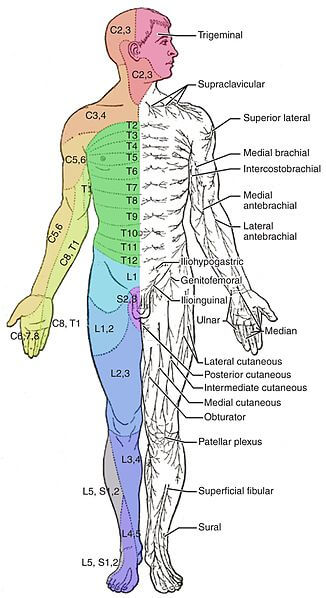
Spinal Stenosis Causes
The majority of spinal canal stenosis cases are caused when something occurs within the spinal column that narrows the canal. Although, some individuals are born with a narrow spinal canal, these cases are more infrequent.
Causes of spinal stenosis
- Osteoarthritis and ligament thickening:
- Wear and tear on the spinal column can occur with age, structural imbalance, or disease process. This wear and tear typically presents itself with bone spurs and ligamentous thickening that can narrow the spinal canal.
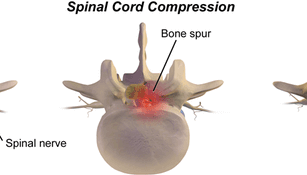
- Herniated Discs:
- Disc bulges and herniated discs can occur from injury, microtraumas, or the aging process. When the outer layer of a spinal disc tears, the inner material can seep out and cause narrowing of the spinal canal and put pressure on the spinal cord and nerves.
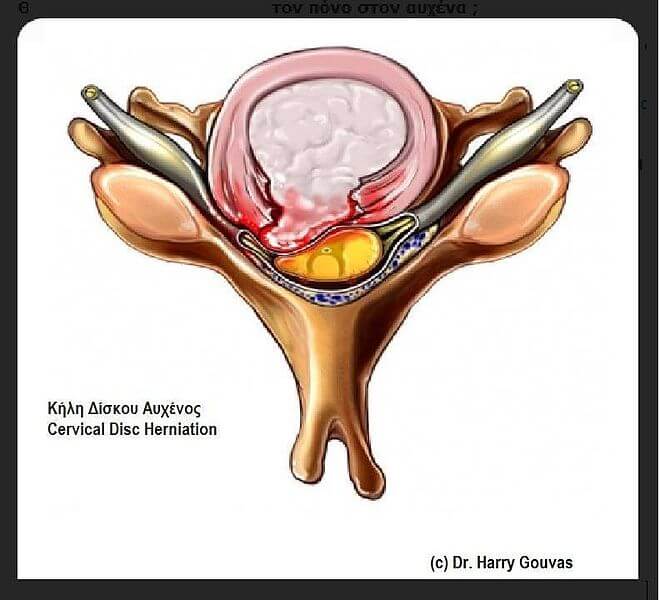
- Tumors:
- Abnormal benign or malignant growths can sometimes occur within the spinal column and/or spinal cord. These growths can cause pressure on the spinal cord and nerve roots as well as spinal canal narrowing.
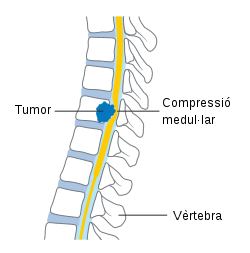
- Injuries and Traumas:
- Injuries and traumas such as motor vehicle accidents, slips, falls, and/or sports injuries can cause spinal stenosis. This occurs when the injury causes fractures, dislocations, and swelling to structures within the spinal column.
- Spondylolisthesis
- Spondylolisthesis is a condition of spinal instability where one vertebrae slips out of place in relation to the vertebrae below. This condition can put pressure on the spinal cord and nerve roots causing spinal canal stenosis and/or neuropathy.
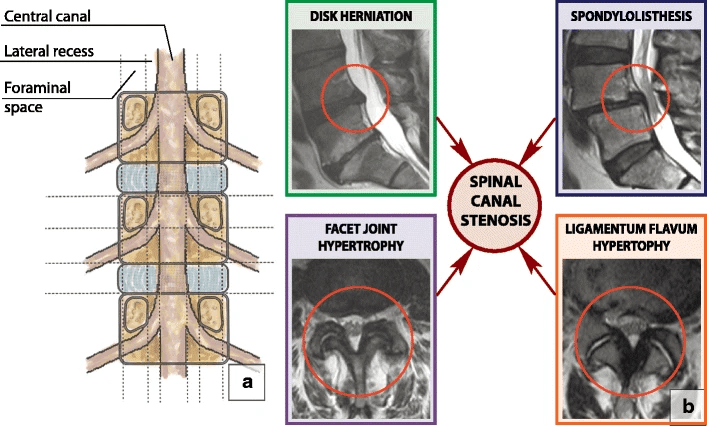
Risk factors of spinal stenosis
Spinal canal stenosis is most often seen in people over the age of 50 due to degenerative diseases such as osteoarthritis, ligament thickening, degenerative disc disease and other degenerative processes. Though degenerative processes can occur in younger individuals. Aside from degenerative processes, other causes must always be considered and ruled out. These causes include herniated discs, tumors, fractures, dislocations and inflammatory processes.
Treatment for spinal stenosis
In general, unless your symptoms are of severe nature, treatment will start with conservative methods. Conservative methods of care are typically provided by a chiropractor or physical therapist. If symptoms are severe and/or if conservative methods fail, surgical intervention will be discussed.
When to see your doctor
If you have any of the symptoms listed above you should seek help from a medical professional such as a Chiropractor, Physical Therapist, or your primary care physician.
Seek help if you think you may have spinal stenosis
In cases that are left untreated, spinal stenosis may cause permanent damage. Permanent damage such as numbness, weakness, atrophy, balance problems, incontinence, and/or paralysis may occur in rare cases, especially if left untreated.




